|
|
|
|
|
English
|
Japanese
|
Chinese
|
Sanskrit / Pali
|
Korean
|
Tibetan
|
|
Buddha of
Limitless
Light & Life;
Pure Land Lord
|
Amida Nyorai
阿弥陀如来
|
Amituo, A-mi-t'o
Āmítuó Fó
阿彌陀佛
阿彌陀
|
Amitabha
Amitābha
Amitāyus
Amrta, अमिताभ
|
Amita
Amit'a
아미타
|
O-pa-me
Ö-pa-me
Wopakme
Od dpag med
|
|
Sanskrit Amitabha and Amitayus both mean “limitless life.” Sanskirt Amrta means “immortal.”
|
|
 AMIDA BUDDHA AMIDA BUDDHA

Buddha of Infinite Light and Life
Lord of the Beyond and the Afterlife
Lord of Gokuraku, the Land of Ultimate Bliss
Savior of Japan’s Pure Land Sects
Origin = India
Amida is one of the loftiest savior figures in Japanese Buddhism, and Amida faith is concerned primarily with the life to come, the life in the beyond. Amida is described in the Amitābha Sūtra 阿彌陀經, the Sutra of Infinite Life 無量壽經, and many other Mahayana texts. Amida is the central deity of Japan’s popular Pure Land (Jōdo 浄土) sects and the ruler of the Western Paradise of Ultimate Bliss (Gokuraku 極楽; Skt. = Sukhāvatī). To followers of Japan’s Pure Land sects, Amida has eclipsed the Historical Buddha as the most popular divinity in Japan's Mahayana traditions. Even today, the Pure Land sects of Japan are among the nation’s largest and most popular.
Amida appears with great frequency in Japanese religious painting and statuary, and is often accompanied by two main attendants in artwork called the Amida Sanzon 阿弥陀三尊 (lit. = Amida Triad), which depicts the three descending from above to welcome the souls of the dying into Amida’s pure land. Amida is also one of the Five Tathagata of Wisdom, and thus appears frequently in the mandala of Japan’s esoteric sects, where he reigns over the western quarter and is sometimes shown atop a peacock or goose. Famous examples of Amida art include Amida & Bosatsu on Clouds at Byōdō-in Temple (near Kyoto) and the Big Buddha statue (in Kamakura). Also, numerous Jōdo Mandala & Jōdo Sanmandara depict Amida's paradise and the non-Tantric deities of Japan's Pure Land sects.

Esoteric Mantra for Amida Buddha in Japan = On Amiritateisei Karaun
Hōzō 法蔵 (Hozo) Becomes Amida
Before attaining Buddhahood, Amida was known as Hōzō Bodhisattva (Skt. Dharmakāra). Hōzō made 48 Vows which serve as the basis for the modern vows taken by lay followers, monks, and nuns in Tibet, China, and Japan. In the 48 Vows, Hōzō pledged that, upon attaining Buddhahood, he would create the Western Pure Land of Ultimate Bliss (the terms Jōdo = Pure Land, and Gokuraku = Land of Ultimate Bliss, refer to the same realm). Hōzō guaranteed rebirth there to anyone who repeatedly chanted his Nembutsu 念仏 (prayer) with utmost sincerity, even those on their death bed who had been great sinners in their life. The nembutsu (nenbutsu) is “Namu Amida Butsu,” which is variously translated as “All Hail Amida Buddha” or "Oh Compassionate Amida Buddha." Hōzō fulfilled the vows and thereafter became Amida Nyorai. For a few more details on Hōzō Bosatsu, please click here.
|
Amida’s Various Forms & Names
Amida has numerous names and is depicted in various manifestations in Japan. Some of the most important include:
- Amida as one of the 13 Buddha 十三仏 (Jūsanbutsu) of the Shingon Sect of Esoteric Buddhism (Mikkyō 密教). In this role, Amida presides over the memorial service held on the second-year anniversary following one's death.
- Amida as one of the Five Tathagata of Wisdom.
- Amida as the patron deity for people born in the Zodiac Years of the Dog and the Boar.
- Amida Raigō 阿弥陀来迎; Amida in Welcoming Descent
- Amurita 甘露, Amurita-ō 甘露王 (Skt. Amrta); Immortal Buddha; important to Esoteric sects
- Gokōshii Amida 五劫思惟阿弥陀; Amida contemplating for Five Kalpa
- Guhari Amida 紅玻璃阿弥陀; Amida with red skin
- Hafuki Amida 歯吹阿弥陀; Amida with open mouth
- Hōkan Amida 宝冠阿弥陀; Amida with Jeweled Crown
- Jūni Kōbutsu 十二光佛, Twelve Buddha of Light, 12 Ephithets of Amida, 12 Titles of Light; as given in the Larger Sūtra of Immeasurable Life (Muryōjukyō 無量壽經), they are: immeasurable, boundless, irresistible, incomparable, flaming, pure, joy, wisdom, uninterrupted, difficult to conceive, ineffable, surpassing sun and moon. See also Dapankara.
- Kubon Amida 九品阿弥陀; Amida of Nine Levels of Birth in Paradise
- Mikaeri Amida 見返り阿弥陀; Amida Looking Back
- Muryōju Butsu 無量壽佛; Buddha of Limitless Life
- Muryōju Nyorai 無量壽如來; Tathagata of Limitless Life
- Muryōju-ō 無量壽王; Lord (King) of Limitless Life
- Muryōkō Butsu 無量光佛; Buddha of Limitless Light
- Yamagoe Amida 山越阿弥陀 (aka Yamagoshi-no-Amida); Amida Coming Over the Mountain.
Other English Translations
- Buddha of Boundless Light and Life
- One of Immeasurable & Infinite Qualities
- Amida Buddha, Amida Tathagata, Amida Nyorai
|

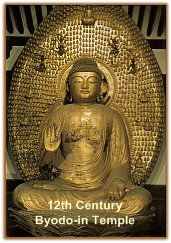  Early History of Amida in Japan Early History of Amida in Japan
Buddhist scholar Robert E. Morrell says it is a “remarkable accident of history” that a Pure Land school devoted to Amida was not introduced to Japan along with the original Six Nara Sects (Nara Era = 710 to 793 AD), for faith in Amida was known in Japan already by Prince Shotoku’s time (573 - 621 AD). In the Heian Era (794-1192 AD) came the Tendai and Shingon schools of Esoteric Buddhism. Together they are known as the Eight Schools of Early Buddhism in Japan. Only in the Kamakura Era (1185-1333 AD) do we see the pronounced emergence of the Pure Land sects devoted to Amida.
90-Day Circumambulation
Jōgyōzanmai 常行三味 (also Jōgyōsanmai)
Faith in Amida’s Pure Land Sect (Jōdoshū 浄土宗) can be traced back to the Six Dynasties Period in China (317-589 AD). Buddhism arrived later in Japan, in the 6th and 7th centuries AD. By the Heian Era (794-1192), Amida worship had gained some favor among the Japanese court, scholars, and monasteries. One practice of particular note was the so-called 90-Day Circumambulation, in which devotees walked constantly around an effigy of Amida, and without letup, chanted the name of Amida Buddha while meditating upon the deity. Various halls, called Jōgyō Sanmaidō 常行三味堂 (Jogyo Sanmaido) were built for this practice. Says the JAANUS Online Dictionary: “Ennin 圓仁 (794-864 AD), the third head priest at the Tendai sect (Tendaishū 天台宗) temple at Enryakuji 延暦寺 on Mt. Hiei 比叡 in Shiga prefecture built the first Jōgyōdō Hall in 851 AD. The one now extant was built in 1595 and is connected to the Hokkedō 法華堂 (also Hokke Sanmaidō 法華三昧堂) by a 6-bay corridor, 12.58 meters long, that stretches between the two bays. The latter hall enshrines a statue of the Historical Buddha and a copy of the Lotus Sutra (Jp. = Hokkekyō 法華経), which is recited during circumambulation. The only other extant pair of halls, known as Jōgyō Sanmaidō and Hokke Sanmaidō, are at Rinnōji Temple 輪王寺 in Tochigi prefecture, dating from 1619 AD.” <end quote from JAANUS >
Days of the Dharma. Another factor that engendered faith in Amida was a widespread belief in those bygone days of the Three Periods of the Law (Jp. = 三時 sanji, shōzōmatsu, shozomatsu; also known as the Days of the Dharma. This was an all-encompassing concept of society’s rise and fall that originated much earlier in Indian Buddhism but came to prominence later in China and then Japan. It foretold of the world’s ultimate decay and the complete disappearance of Buddhist practice. At the time, the Days of the Dharma in Japan were divided into three periods, the first phase lasting 1000 years (Age of Shōbō 正法) after the death of the Historical Buddha (then given as 949 BC), a golden period during which Buddhism gained acceptance and spread, and in which followers had the capacity to understand the Dharma (the Buddhist teachings). The second phase (Age of Zōhō 像法) would also last 1000 years, during which Buddhist practice begins to weaken; and the third and final phase lasting 3,000 years (the Age of Mappō 末法), when Buddhist faith would deteriorate and no longer be practiced. In Japan, the Age of Mappō (or Mappo) was scheduled to begin in 1052 AD, and a sense of foreboding thus filled the land, with people from all classes yearning for a gospel of salvation. The development of Japan’s Pure Land sects, and their exclusive devotion to Amida Buddha, should be viewed against this backdrop.

 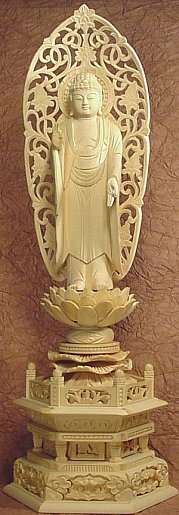
Modern Amida Wood Carvings
From online store Buddhist-Artwork.com

  Buddhism for the Common Folk Buddhism for the Common Folk
Faith in Amida Buddha remained largely confined to a small segment of the Japanese population until the Kamakura Era (1185-1333), when it was popularized by new Pure Land (Jōdo 浄土) sects committed to bringing Buddhism to the illiterate commoner. These sects expressed concern for the salvation of the ordinary person, and stressed pure and simple faith over complicated rites and doctrines. See From Court to Commoner Buddhism for details.
Their leaders, Hōnen 法然 and his disciple Shinran 親鸞, taught that anyone could attain salvation by faithfully reciting the name of Amida Buddha. Even today, the key practice for Amida devotees is simply to chant Amida’s nembutsu 念仏 (prayer), “Namu Amida Butsu,” for Amida Nyorai vowed that whoever calls his name with faith shall be reborn in a paradise called the Pure Land. In modern terms, Amida faith is a Mahayana philosophy that represents the “quick path” to enlightenment. Those who live in Amida’s Western Pure Land of Bliss (Jōdo 浄土 or Gokuraku 極楽, a land devoid of worry or toil), can focus their energies on attaining Buddhahood. Here, in the Pure Land, they have escaped the Six States of Existence -- they are no longer trapped in the cycle of birth and death (Skt. samsara), and can thus devote all efforts to attaining enlightenment.
Three deities -- Amida Buddha (this page), Kannon Bodhisattva, and Jizo Bodhisattva -- are intimately connected with Japan's popular Pure Land sects. All three became extremely popular saviors among the common people in the centuries that followed. Even today, these three remain the bedrock of folk Buddhism in modern Japan -- Amida for the life to come in paradise, Kannon to assist those in distress in the earthly life, and Jizo to protect against the torments of hell. Both Kannon and Jizo serve Amida.
The Nichiren Sect, another important sect founded in the Kamakura period, adamantly rejects the Amida “quick path” to salvation, claiming it actually harms Buddhist belief, for it does not prompt people to pursue a life of reflection and improvement. It is a false doctrine to adherents of the Nichiren Sect, for Amida faith lulls people into believing they need not practice Buddhism during their lifetime -- to gain salvation, they need only repent on their deathbed, even if they were bad people during their lifetime. To Nichiren devotees, chanting alone will not bring salvation. It is only a first step, a preliminary practice, in religious advancement. It must be followed by rigorous Buddhist practice and meditation. The Nichiren sect thus holds Amida worship in low esteem.
Brief History of Japan’s Pure Land Sects. The Jōdo 浄土 (Pure Land) sects came to prominence in the Kamakura era, although Jōdo faith was practiced in Heian times by Japan’s court and monasteries. Japan’s Pure Land Sect (Jōdoshū 浄土宗) was founded by Hōnen Shōnin 法然上人 (1133-1212; also spelled Honen Shonin). His disciple Shinran 親鸞 (1173-1262) founded the Jōdo Shinshū 浄土真宗 or True Pure Land sect. Both Honen and Shinran taught that anyone, whether noble or peasant, could gain rebirth in the Pure Land by faithfully reciting the name of Amida Buddha -- chanting the invocation “Namu Amida Butsu” with devotion would lead to rebirth in the Pure Land Paradise. The popularity of Jōdo faith among commoners was a serious challenge to the institutionalized Buddhist monasteries in Kyoto and Nara, which attempted to block this popularization by proclaiming it subversive to public order and by condemning Hōnen, Shinran, and their followers to exile.
Shinran, in particular, provoked Buddhist authorities by declaring that meat eating and matrimony were not contrary to the Buddha’s teachings, even though the reigning Buddhist sects forbade both practices among clergy. Shinran was expelled from the monastic community for taking a wife. He further angered the establishment by declaring Amida faith alone as sufficient for salvation, other Buddhist deities and practices being unnecessary. In later years, his followers extolled the virtues of religious practice among the laity, and argued that a spiritual secular life was just as valid as a monastic life. Indeed, the monastic ideal was discarded. The sect’s priests stopped shaving their heads and started dressing in ordinary clothes. They did not consider themselves enlightened, but part of a community of seekers. Today, Hōnen’s school (Jōdo) remains monastic, while Shinran’s sect (Jōdo Shin) is purely a lay Buddhist group, one of the largest in Japan. By stressing pure and simple faith over complicated rites and doctrines, and by allowing believers to enjoy worldly benefits with the promise of salvation in the afterlife, the Pure Land schools gained widespread popularity among the peasantry. Today, the Pure Land sects, along with the Nichiren Sect (also founded in Kamakura Period), are the leading sects of Japanese Buddhism. For more details, see From Court to Commoner Buddhism in the Kamakura Era.
 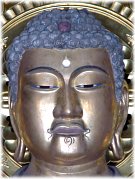
Amida Nyorai (Buddha)
Click thumbnail images to see enlarged photos.
Located at Hase Dera in Kamakura
This gilt statue is about three meters high
Reportly made during Minamoto Yoritomo’s time (Kamakura Period)
It is worshipped to ward off calamities that occur in the “unlucky ages”
(yakudoshi 厄年 in Japanese); according to the Japanese, the years especially
prone to misfortune for men are 25 and 42, and for women 19 and 33.

Descent from Paradise
Amida Nyorai presides over the Great Western Paradise. When a devotee dies, it is believed that Amida descends from his paradise to lead the faithful back to the Pure Land. In paintings and scrolls, this is generally depicted by showing Amida riding atop a cloud, often accompanied by two Bodhisattva, Kannon and Seishi, who are Amida’s main attendants. In addition, Amida artwork often depicts Amida surrounded by 25 Bodhisattva (including Kannon and Seishi) descending from heaven to guide departed souls back to paradise. See Amida Raigo Triad for more photos and details about Amida’s descent. In sculpture, Amida is sometimes accompanied by Bosatsu on Clouds, but most frequently attended by Kannon and Seishi.
 
Amida descends from heaven to lead followers back to paradise
(L) Unknown, found at Studio Kokuu
(R) Kamakura Era Scoll from Herbert F. Johnson Museum of Art


Goshiki no Ito 五色の糸 = Five-Colored Cord
During the Heian period, the tradition of hanging a scroll of
Amida Nyorai in front of a dying person was established.
A five-colored cord was attached to the scroll and extended
into the hands of the dying person. According to Pure Land
believers, if the dying person held firmly to the cord during
the final moments of life, s/he was assured direct passage
to Amida's Western Paradise (Jp. = Gokuraku or Pure Land).
For much more on the number five and its
significance, please see the Number Five page
Above Photo
Modern Replica of 12th-13th Century Painting
Amida Buddha Coming over the Mountains
Replica adds the Five-Colored Cord
Photo courtesy Ryukoku University (J-site)

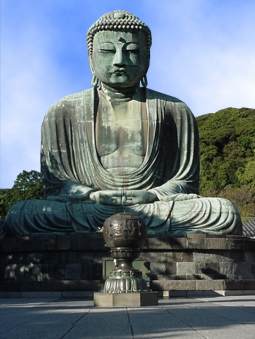  Big Buddha in Kamakura Big Buddha in Kamakura
Constructed in 1252. Of the three most widely known giant effigies of Buddha from old Japan, only the Kamakura Daibutsu (11.3 meters) remains in original form. The Nara Daibutsu (15 meters) was recast, while the famous Kyoto Daibutsu (24 meters) was entirely destroyed in a fire. All that remains of this once spectacular landmark is a small wooden model (maquette). See Big Buddha page for descriptions of all three and others, plus more photos.
The Kamakura Daibutsu is roughly 11.3 meters in height (without the pedestal) and weighs 124 tons . Upon the head are 656 curls, a traditional characteristic of the Amida Buddha. The silver boss on the forehead (from which emanates the light that illuminates the universe) weighs 30 pounds. More details here.
PHOTOS OF KAMAKURA’S GREAT BUDDHA
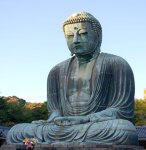  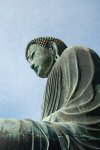 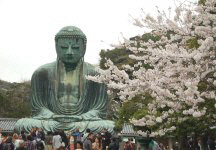
Great Buddha of Kamakura (Kamakura Daibutsu) -- an effigy of Amida Nyorai.
Click images to enlarge. All photos by Mark Schumacher.

ABOUT HŌZŌ BOSATSU
Hōzō (Houzou, Hozo) Bosatsu 法蔵菩薩
Hōzō Bosatsu (Skt. = Dharmakāra) appears in the Sutra of Infinite Life (Muryōjukyō 無量壽經; Skt. Sukhavatiyuha Sutra). As a human, Hōzō was a king who gave up his throne after hearing the teachings of Lokesvararaja Buddha (Sejizaiō Butsu 自在王佛). He became a monk, and after eons of practice, he became Dharmakāra Bodhisattva (Hōzō Bosatsu 法藏菩薩), who then made 48 vows, fulfilled them, and became Amida Nyorai.
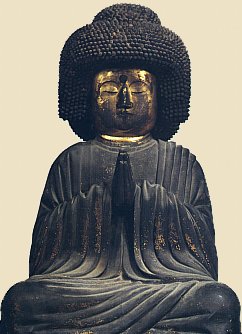 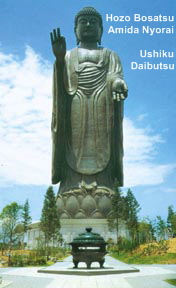
Gokō Shiyui Amida 五刧思惟阿弥陀 (aka Hōzō Bosatsu). Tōdaiji Temple (Nara), H = 106.6 cm, Muromachi Era.
Hōzō practiced for an inconceivably long time (five kapla = 五刧 = Gokō), and is thus shown here with thick hair.
R: Ushiku Daibutsu (Hōzō Bosatsu), 100-meters high. Ibaraki Prefecture. Click here for photos of this statue.

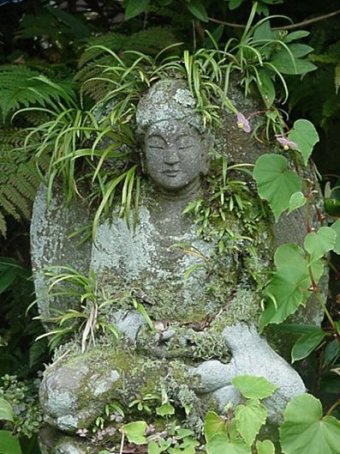
Amida Nyorai (stone carving) in private garden, Kamakura
Early Meiji Period. Visit 8 Buddhist Protectors of the Zodiac for More

|
Nine Levels of Rebirth (Kubon / Kuhon 九品) in Amida’s Pure Land
Amida’s Pure Land is composed of nine different levels or grades, and devotees are reborn into one of the nine. In Japan, the nine levels are sometimes represented in Amida paintings and sculpture by nine different mudra (hand gestures). These nine mudra are known as the Amida Kubon-in 阿弥陀九品印; also read Kuhon-in (lit. = Mudra of the Nine Levels of Rebirth).
Says JAANUS: The KANMURYOUJUKYOU 観無量寿経 (Sutra on the Meditation of Amitayus; Chn. = Kuan Wuliangshou Jing) mentions nine grades/levels of Amida's welcome, but does not mention nine corresponding mudras. Nor do the nine forms of Amida display nine different mudras in the Kubon Mandala 九品曼荼羅, which E'un 恵運 (798-869) brought back to Japan from China. Many temples enshrining nine corresponding forms of Amida were constructed in the Heian period, based on the theory of nine grades of rebirth. The only extant example is found at Jōruriji Temple 浄瑠璃寺 in Kyoto (see photos below). Instead of the nine figures each displaying a different mudra, the central deity at this temple forms the "upper grade: lower birth" mudra, while the other eight images form the "upper grade: upper birth" mudra. In contrast, the nine Edo-period images of Amida at Kuhonbutsu Jōshinji 九品仏浄真寺 in Tokyo (see photos below) present faithful representations of the nine different mudras, thus indicating that the theory had won considerable currency by the Edo period. Recent research has shown that dissemination of the Amida Kubon-in (Amida’s nine mudras) occurred after the publication of the BUTSUZOUZUI 仏像図彙 (Collected Illustrations of Buddhist Images) in the Genroku 元禄 era (1688-1704). <end JAANUS quote>
|
|
|
|
Upper Grade
Jōshō 上生
|

Upper, Upper Birth
Jōbon Jōshō 上品上生
|

Upper, Middle Birth
Chūbon Jōshō 中品上生
|

Upper, Lower Birth
Gebon Jōshō 下品上生
|
|
|
|
Middle Grade
Chūshō 中生
|

Middle, Upper Birth
Jōbon Chūshō 上品中生
|

Middle, Middle Birth
Chūbon Chūshō 中品中生
|
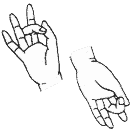
Middle, Lower Birth
Gebon Chūshō 下品中生
|
|
|
|
Lower Grade
Geshō 下生
|

Lower, Upper Birth
Jōbon Geshō 上品下生
|

Lower, Middle Birth
Chūbon Geshō 中品下生
|
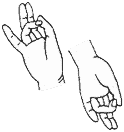
Lower, Lower Birth
Gebon Geshō 下品下生
|
|
Source of Clipart: Web Site of Jodo Shu Headquarters, Honen Buddhism
|
|
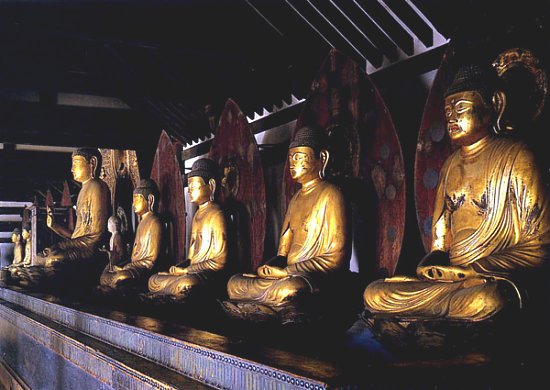
Jōruriji Temple 浄瑠璃寺 (Kyoto Pref.)
Dated to the Fujiwara Period 969 - 1185, Wood
Central Amida statue is approx. 2.3 meters in height.
Central deity forms the "upper grade: lower birth" mudra,
while other eight form "upper grade: upper birth" mudra.
Yoseki Zukuri 寄木造り style, National Treasure 国宝
PHOTO: J-Site 1 and J-Site 2
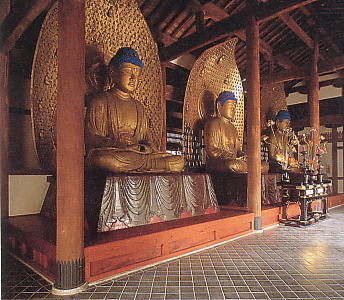
Kuhonbutsu Jōshinji Temple 九品仏浄真寺
The nine Amida statues are disperse, three each in three Amida Halls. Photo: This J-Site
|
|

|
Nine Amida of Rebirth
|
|
|
|
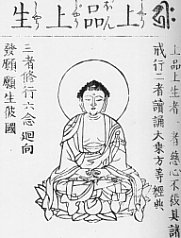
Upper: Upper Birth
上品上生
|
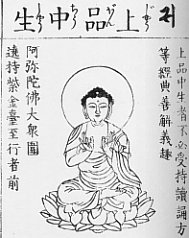
Upper: Middle Birth
上品中生
|
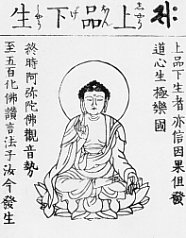
Upper: Lower Birth
上品下生
|
|
|
|
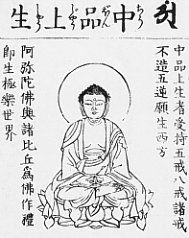
Middle: Upper Birth
中品上生
|
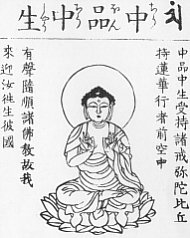
Middle: Middle Birth
中品中生
|

Middle: Lower Birth
中品下生
|
|
|
|
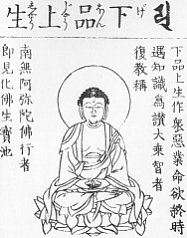
Lower: Upper Birth
下品上生
|
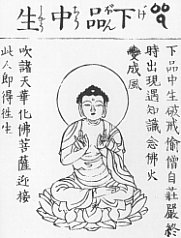
Lower: Middle Birth
下品中生
|
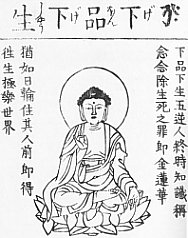
Lower: Lower Birth
下品下生
|
|
|
|
Source of Clipart: Clipart Source: Butsuzō-zu-i 仏像図彙, the "Collected Illustrations of Buddhist Images." Published around 1690. One of Japan's most important studies of Buddhist iconography, with drawings by Tosa Hidenobu 土佐秀信 and text by Ito Takemi 伊藤武美. Hundreds of pages and drawings, with deities classified into approximately 80 (eighty) categories. Modern-day reprints are available for purchase at most large Japanese book stores, or click here to purchase online.
|
|

Mikaeri Amida 見返り阿弥陀 (Amida Looking Back)
The famous Mikaeri Amida, a statue showing Amida looking back, is located at Zenrin-ji Temple 禅林寺 (Kyoto). See photos below. For more on Zenrin-ji, also known as Eikando, please click here (outside link). For a list of the temple’s treasures, click here (outside link). One of the chief priests of this temple was Yokan (1033-1111), who is commonly known as Eikan 永観. According to legends from the temple, on the early morning of 15 Feb. 1082, Eikan was conducting "Nembutsu" chants to Amida Buddha while walking around the altar. When the Amida statue stepped down from the altar and began to lead Eikan to salvation, the monk became stunned and stopped walking. This prompted Amida to look back over the left shoulder and proclaim "Eikan, you are slow." Eikan then awoke from his dream, deeply impressed by the merciful head-turned pose of Amida. He pleaded with the deity to keep the pose forever. Since then, this Amida statue has been known as the "Mikaeri Amida (Amida Looking Back)." This pose symbolizes Amida's mercy and patience in waiting for those who are late in gaining faith. <Story from the temple’s website>
 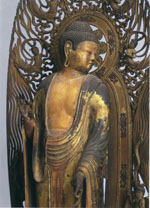 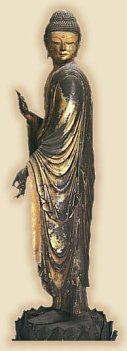
Mikaeri Amida 見返り阿弥陀 (Amida Looking Back)
Zenrin-ji Temple 禅林寺 (Kyoto)
77 cm in height, Late Heian to Early Kamakura Period

|
LEARN MORE ABOUT AMIDA NYORAI
- Buddhist-Artwork.com. Amida Buddha statues are available for online purchase.
Buddhist Artwork is our sister site.

|
|
|
|